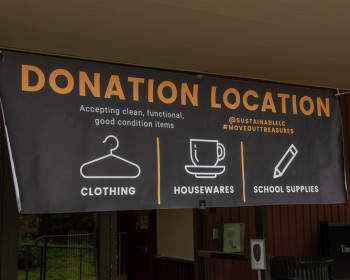Brown is the new Green
Open gallery

As part of Lewis & Clark’s commitment to sustainability, a new program is being adopted this year to conserve natural and economic resources. This year only plants, shrubbery, and trees will be watered and the grassy areas will be allowed to go naturally dormant. The College will see savings in both water and electrical consumption. The labor normally used to maintain the lawn areas will be diverted to work on removing invasive plant species on the campus. When the rains return, the grass will return to its lush green color.
The Source sat down with Grounds Supervisor Gabe Bishop to find out more.
Why did the Executive Council decide to let the lawns go brown?
Their decision was based on conserving natural resources, saving money, and reducing fertilizer and pesticide use. While this may not encourage the social gathering that green grass offers, the decision to let the lawns go brown makes a significant impact toward conserving our resources. We’ll also be able to free up resources previously devoted to mowing and repairing the lawn watering irrigation systems.
What will ground maintenance workers focus on instead of lawn care?
Our main focus this summer will be removing invasive species like English Ivy, Himalayan Blackberries, Laurel and Holly. We’re also planting native species in those areas to try to compete with the invasive species that we removed.
How does this new plan save money?
While 60 percent of the area we irrigate on the CAS campus comes from our well, the other 40 percent is pumped up to Palatine Hill from the City of Portland. We’re trying to use as much well water as we can, but we are only allowed to pull 50 gallons per minute out of our well. So by reducing water usage, we can eliminate the electricity needed to run our pumps, as well as save ourselves on the cost of the expensive city water. We also decided to drain the lower campus reflecting pool which normally holds 60,000 gallons of water. The reflection pool doubles as a water holding tank for our irrigation system. We felt it would not make sense to have a full reflection pool surrounded by dormant lawn when trying to conserve money and water.
How much water has the new plan saved?
This fall, the City of Portland will send us a statement detailing how much water we used over the summer. At that point, we’ll be able to compare our summer water usage with last summer and figure out how much money and water we saved.
What other measures has the grounds crew taken to be environmentally friendly?
We’ve implemented several new practices. Last winter, we used a green seal approved ice melt. For the last two years, we’ve switched to using only organic fertilizers and completely eliminated the use of synthetic fertilizer which takes a large amount of oil to produce. We also bought a compost tea machine last year that extracts beneficial nutrients and microorganisms from compost and turns it into a liquid that we can then spray on our plants and shrubs. The liquid reduces fungus by making plants more healthy and disease resistant. So far, the machine has allowed us to eliminate the use of fungicides altogether. We also purchased the Grounds Department’s first electric work vehicle to join our growing fleet of electric vehicles in Facility Services.
For more information, please contact Facilities Services at x7845.
More Sustainability at Lewis & Clark Stories
Sustainability Office is located in Fowler Student Center on the Undergraduate Campus.
MSC: 134
email advorak@lclark.edu
voice 503-768-7794
Senior Director of Sustainability Amy Dvorak
Sustainability Office
Lewis & Clark
615 S. Palatine Hill Road
Portland OR 97219
Office Hours: Thursdays 1 - 3:00 p.m.

